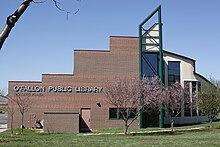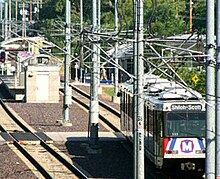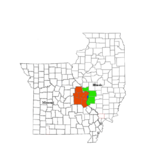Metro East
This article needs additional citations for verification. (March 2012) |
St. Louis Metro East | |
|---|---|
 | |
| Country | |
| State | |
| Largest city | Belleville, IL |
| Other cities | |
| Elevation | 142–390 m (466–1,280 ft) |
| Population (2020) | |
• Total | 681,678 |
| Time zone | UTC−6 (CST) |
| • Summer (DST) | UTC−5 (CDT) |
| Area code(s) | 217, 314, 447, 557, 573, 618, 636, 730 |
The Metro East is an urban area in Southern Illinois, United States that contains the eastern and northern urban, suburban, and exurban areas on the Mississippi River in Greater St Louis. It encompasses eight Illinois counties and constitutes the second-most populous metropolitan area in Illinois.
A historically significant region, the area included the mound building native culture of Cahokia, and the later French settlements of the Illinois Country. It also includes the fertile lands of the riparian American Bottom. The region has almost 700,000 residents and its most populated city is Belleville, with 42,404 residents.[1] The area hosts several colleges and universities, with Southern Illinois University, Edwardsville as the largest. Also located in Metro East is Scott Air Force Base.
Geography
[edit]

The Metro East is a loose collection of small and mid-sized cities sitting along the American Bottom and the bluffs of the Mississippi River. According to the U.S. Census Bureau, the eight counties of the region have a total area of 6,974 km2 (2,692 mi2). 6,787 km2 (2,620 mi2) of it is land and 186 km2 (71 mi2) of it (2.74%) is water.
As of the 2020 census, the most populated cities in the region included the following[2]
|
Principal cities |
City populations[3]
|
Demographics
[edit]As of the 2010 census, there had been a major shift in population from the older rust belt industrial cities in the Mississippi River bottom, such as East St. Louis and Alton, to the more suburban satellite cities, such as, Belleville, Edwardsville, and O'Fallon sitting on the bluffs. This is mainly due to continued white flight.[4]
As of the census[5] of 2000, there were 599,845 people, 229,888 households, and 160,260 families residing in the eight Metro East counties.
The most common language is English, although various other languages are spoken. German speakers exist in southeastern Madison, and Clinton, and southern and eastern St. Clair Counties. Spanish is spoken in the Fairmont City area, and in parts of Clinton County. The largest concentration of African-Americans is in Madison, Venice, western Granite City, East St. Louis, Washington Park, Belleville, Cahokia, Alorton and Alton.
List of counties
[edit]List of cities, towns, and villages
[edit]Notes:
- ^ means part of city in another county/counties
- Bold indicates county seat
Bond County
[edit]
|
|
Calhoun County
[edit]Clinton County
[edit]
|
Jersey County
[edit]
|
Macoupin County
[edit]
|
|
|
Madison County
[edit]
|
|
|
Monroe County
[edit]St. Clair County
[edit]
|
|
Colleges and universities
[edit]- Greenville University
- Kaskaskia College
- Lewis and Clark Community College
- McKendree University
- Principia College
- Southern Illinois University Edwardsville
- Southwestern Illinois College
Transportation
[edit]State routes
[edit]U.S. routes
[edit]Interstate freeways
[edit]Public transit
[edit]
Public transit service in St. Clair County is provided by Metro Transit in partnership with the St. Clair County Transit District. Service includes local bus lines and the MetroLink light rail system. MetroLink has 11 stations in Illinois between the East St. Louis Riverfront and Scott Air Force Base. It links the suburban Metro East to St. Louis Lambert International Airport on the Red Line and Shrewsbury, Missouri on the Blue Line. Intermediate stops include downtown St. Louis, area universities and hospitals, and downtown Clayton.
In 2019, the St. Clair County Transit District was awarded $96 million in Illinois infrastructure funding to build a 5.2-mile (8.4 km) extension of the Red Line from Shiloh-Scott to MidAmerica St. Louis Airport in Mascoutah.[6] This extension will include two 2.6-mile (4.2 km) segments, a double-track and a single-track segment, along with a station at the airport.[7] Construction on the extension began in 2023 with Metro expecting to begin operations in early 2026.[8][9][10]
Additionally, Madison County Transit operates local bus service in that county with routes that serve downtown St. Louis transit centers.[11]
Major employers
[edit]- Anheuser-Busch
- Boeing
- Charter Communications
- Illinois Department of Transportation
- Monsanto
- National Steel
- Norrenberns Trucking
- Olin Corporation
- Scott Air Force Base
- Southern Illinois University Edwardsville
- U.S. Steel
- Wood River Refinery
Notable attractions
[edit]- National Shrine of Our Lady of the Snows, Centreville, near Belleville; operated by the Missionary Oblates of Mary Immaculate
- Brooks Catsup Bottle, Collinsville
- Belle Clair Fairgrounds and Expo Center, Belleville
- Cahokia Mounds, Collinsville, on Madison-St. Clair County line
- GCS Ballpark, Sauget
- Gateway International Raceway, Madison
- Eads Bridge, historic bridge, among East. Louis, on the East St. Louis, Illinois, and St. Louis, Missouri border, over the Mississippi River
- Pere Marquette State Park, Grafton
- St. Clair Square, Fairview Heights
- Robert Wadlow Statue, Alton
- Horseshoe Lake, Pontoon Beach, Madison, and Granite City
- Alton Square Mall, Alton
- Carlyle Lake, Carlyle
- National Building Arts Center, Sauget
Residents, historic figures, and contributors
[edit]- Josephine Baker, East St. Louis, performer and activist
- Jason Boyd, Edwardsville, AAA pitcher
- Ray Bradbury, Belleville, science fiction author
- Jimmy Connors, East St. Louis and Belleville, tennis player
- Neal Cotts, Lebanon, former MLB pitcher
- Brian Daubach, Belleville, former MLB 1B/DH/outfielder
- Miles Davis, East St. Louis and Alton, jazz artist
- Lea DeLaria, Belleville, jazz singer, actress, and comedian (Orange is the New Black)
- Elizabeth Donald, Edwardsville, horror novelist
- Dick Durbin, East St. Louis, U.S. senator
- Buddy Ebsen, Belleville, television actor
- Jay Farrar, Belleville, musician
- William Holden, O'Fallon, film actor
- Louis Jolliet, explorer of the Mississippi River
- Jackie Joyner-Kersee, East St. Louis, Olympic athlete
- Ken Kwapis, Belleville, film and television director and producer
- Père Jacques Marquette, French discoverer
- T. J. Mathews, Columbia, former MLB pitcher
- Laurie Metcalf, Edwardsville, film and television actress (Rosanne, Uncle Buck, JFK)
- Yadier Molina, Caseyville, Cardinals Baseball catcher (resides there only during baseball season, and is originally from Puerto Rico)
- Jake Odorizzi, Highland, MLB Pitcher
- Van Allen Plexico, Smithton, author and professor
- Peter Sarsgaard, Belleville/Scott AFB, actor (Magnificent Seven, Jarhead, Green Lantern)
- John Shimkus, Collinsville, Congressman from Illinois's 15th congressional district (1997–2021)
- Michael Stipe, Collinsville, lead singer of the band REM
- Jeff Tweedy, Belleville, lead singer of the band Wilco
- Uncle Tupelo, Belleville, alternative country band
- Craig Virgin, distance runner
- Robert Pershing Wadlow, Alton, world's tallest man
- Scott Wolf, Belleville, actor
Media in the Metro East
[edit]St. Louis area TV stations
[edit]- Note: This list is for the entire Metro East area; however, the low-powered stations may not reach the entire five-county Metro East area. WSIU, despite not being based from the St. Louis DMA, is available in Clinton, Washington, and most of St. Clair.
Champaign-Urbana/Decatur/Springfield area TV stations
[edit]- Note: This list is for Jersey County; however, the majority of these stations are not available for most Jersey County residents. These stations are more likely to be available in Greene and Macoupin counties, which border Jersey County.
Paducah/Cape Girardeau/Harrisburg area TV stations
[edit]- Note: This list is for St. Clair, and Clinton counties; however, the majority of the stations, with the exception of WSIU and WPXS and possibly KFVS, are not available for a majority of the St. Clair, and/or Clinton County residents. These stations are more likely to be available in Washington County and the Centralia area.
Daily newspapers
[edit]- Note: daily newspaper coverage depends on county.
- Riverbender.com (Madison, Jersey counties)
- EdGlenToday (Madison county)
- The Metro East Star (St. Clair, Madison counties)
- Alton Telegraph (Madison, Jersey counties)
- Belleville News-Democrat (region-wide)
- Centralia Sentinel (Clinton and Washington counties)
- Southern Illinoisan (mainly in Washington County, rarely found elsewhere in the Metro East)
- St. Louis Post-Dispatch (region-wide)
- Edwardsville Intelligencer (Madison County)
Radio stations
[edit]- Note: stations listed are licensed and have offices in Metro East counties only. Stations that can be heard in the Metro East but not listed have offices outside the Metro East counties.
|
See also: Radio stations in Illinois
The Metro East in film
[edit]- Note, the following is a partial list of films shot, often partially, sometimes with significant production, within the Metro East. All data can be rechecked via the Internet Movie Database.
"Uncredited" means a Metro East location was not credited within the database, but was clearly shot on Metro East soil upon watching the film itself.
- In the Heat of the Night - feature-length film, shot in Belleville, Illinois (1968 Oscar winner for Best Picture of 1967)
- Things Are Tough All Over (uncredited) - feature-length film, shot on the East St. Louis riverfront (1982)
- King of the Hill - feature-length film, shot in Alton, Illinois (1993)
- A Will of their Own - feature-length TV film, shot in Belleville, Illinois (1998)
- The Big Brass Ring - feature-length film, shot in Alton, Illinois (1999)
- Steel City - feature-length film, shot in Alton, East Alton, Godfrey, and Jerseyville, Illinois (2006)
- The Lucky Ones - feature-length film, Shot in Edwardsville, Illinois (2008)
- The Coverup - feature-length film, shot in Alton, Illinois (2008)
- Kingshighway - feature-length film, shot in Fairview Heights, Illinois (2010)
- Joint Body - feature-length film, shot in various locations throughout the Metro East (2011)
Metro East in fiction
[edit]Laurell K. Hamilton has used the Metro East as a setting in several books from the Anita Blake and Merry Gentry series. In the Merry Gentry series, fairies of the Unseelie Court have made their home in Monk's Mound.
Robert J. Randisi set one of his Joe Keough mysteries, East of the Arch (2002), in the Metro East communities of East St. Louis and Fairview Heights.[12]
Awards
[edit]The 2010 issue of Family Circle magazine named Edwardsville third in their "Top 10 Best Towns for Families".[13]
Area codes
[edit]- Area code 217: extreme northeast part of Metro East
- Area code 618: the majority of the Metro East is in this area code.
References
[edit]- ^ "U.S. Census Bureau QuickFacts: Belleville city, Illinois". www.census.gov. Retrieved 2024-02-17.
- ^ Staff (2012). "Main". United States Census Bureau. Retrieved 27 May 2012.
- ^ 2010census
- ^ DOUG MOORE; JEREMY KOHLER; NICHOLAS J.C. PISTOR (20 February 2011). "Metro East growing more diverse, census data show". STL Today. Retrieved 27 May 2012.
- ^ "U.S. Census website". United States Census Bureau. Retrieved 2008-01-31.
- ^ Schlinkmann, Mark (June 14, 2019). "Illinois to pay for long-sought MetroLink extension to MidAmerica Airport". STLtoday.com. Archived from the original on November 2, 2021. Retrieved September 20, 2022.
- ^ "Trajectory for Transit in 2022 Points to Need for Continued Collaboration". January 19, 2022. Archived from the original on February 3, 2022. Retrieved February 2, 2022.
- ^ "When will MetroLink extension to MidAmerica Airport be complete? How much will it cost? - MidAmerica St. Louis Airport (BLV) | Mascoutah, IL". flymidamerica.com. July 14, 2021. Archived from the original on September 20, 2022. Retrieved September 20, 2022.
- ^ Cella, Kim (November 1, 2023). "Construction Underway on MetroLink Extension Project in St. Clair County". St. Clair County Transit District. Archived from the original on November 7, 2023. Retrieved November 7, 2023.
- ^ "Construction underway on 5-mile MetroLink extension from Scott AFB to MidAmerica Airport". STLPR. 2023-12-28. Archived from the original on February 4, 2024. Retrieved 2024-02-05.
- ^ Madison County Transit Overview
- ^ East of the Arch: A Joe Keough Mystery: Robert J. Randisi: 9780312283988: Amazon.com: Books
- ^ "10 Best Towns for Families: 2010" Archived 2017-11-21 at the Wayback Machine, Family Circle, Retrieved on 2010-08-07.


